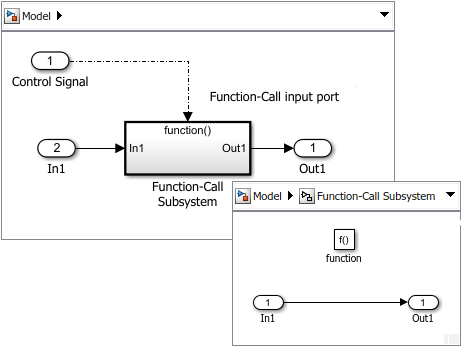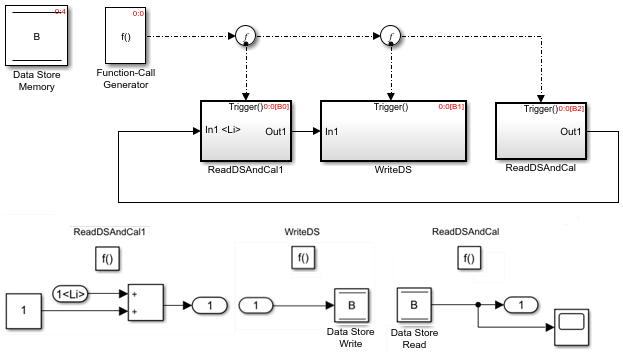Using Function-Call Subsystems
A Function-Call Subsystem block is a conditionally executed subsystem that runs each time the control port receives a function-call event. A Stateflow® chart, Function-Call Generator block, MATLAB Function block, S-Function block, or Hit Crossing block can provide function-call events.

A function-call subsystem is analogous to a function in a procedural programming language. Invoking a function-call subsystem executes the output methods of the blocks within the subsystem in execution order. For an explanation of the Function-Call Subsystem block parameters, see Subsystem.
Creating a Function-Call Subsystem
To create a function-call subsystem:
Add a Function-Call Subsystem block to your model.
Open the subsystem block. Add a block diagram defining the algorithm that is executed when the subsystem receives a function-call event.
Set initial and disabled values for the Outport blocks. See Conditional Subsystem Initial Output Values and Conditional Subsystem Output Values When Disabled.
Set how subsystem states are handled when the subsystem is executed:
Open the subsystem block, then open the block parameters dialog box for the Trigger block. From the States when enabling drop-down list, select an option:
held— States maintain their most recent values.reset— States set to their initial conditions.inherit— Use the held or reset setting from the parent subsystem initiating the function-call.
For nested subsystems whose Function-Call Subsystem blocks have different parameter settings, the settings for the child subsystem override the settings inherited from the parent subsystem. See Trigger.
Attach a function-call initiator to the function-call input port.
If you attach an Inport block, open the block, select the Signal Attributes tab, then select the Output function call check box.
Sample Time Propagation in a Function-Call Subsystem
Configure a Function-Call Subsystem block by setting the Sample
time type of its Trigger Port block to
triggered or periodic.
A triggered (aperiodic) function-call subsystem can execute zero, one, or multiple times during a time step.
If a function-call subsystem is executed by a root-level function-call Inport block with a discrete sample time, multiple function-calls during a time step are not allowed. To allow multiple function-calls, set Sample time to
-1(inherited), and set the sample time for all blocks in the function-call subsystem to-1(inherited).A periodic function-call subsystem executes once during each time step when it receives a function-call signal, and does not execute at a time step when it does not receive a function-call signal. Set the sample time for all blocks in the function-call subsystem to
-1(inherited).
For more information about Sample time type settings, see Function-call subsystems examples in Simulink Subsystem Semantics.
Note
During range checking, the minimum and maximum parameter settings are back-propagated to the actual source port of the function-call subsystem, even when the function-call subsystem is not enabled.
To prevent this back propagation:
Add a Signal Conversion block and a Signal Specification block after the source port.
Set the Output of the Signal Conversion block to
Signal copy.Specify the minimum and maximum values for the Signal Specification block instead of specifying them on the source port.
Latched Input Data for Function-Call Subsystems
You can latch input data for Inport blocks within Function-Call Subsystem blocks to ensure data integrity. To latch input data, in the Inport block parameters, select Latch input for feedback signals of function-call subsystem outputs.
In the following model, input data for the Inport block in the
function-call subsystem ReadDSAndCal1 is latched (indicated by
<Li>) and cannot change during the execution of the subsystem. The
Data Store Read and Data Store Write blocks are called
within each function-call subsystem. The first and second function-calls write data and the
last function-call reads data to the Data Store Memory block.

Note
The root-level data Inport block connected to an internal Inport block is also latched if all of the blocks connected to the root-level block are latched. For more information, see Latch input for feedback signals of function-call subsystem outputs.
Note
Data transfer signals are unprotected in the generated code by default. Use custom storage classes to prevent data corruption in these signals due to preemption of the current task in the target environment.
See Also
Blocks
- Function-Call Subsystem | Function-Call Generator | Function-Call Split | Function-Call Feedback Latch | Trigger | Subsystem
Checks
- Check usage of function-call connections | Check for potentially delayed function-call subsystem return values